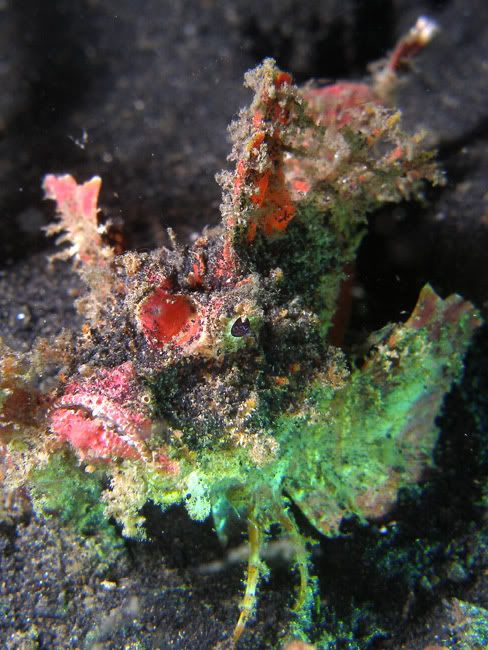About the best Can Lighter photographer I've seen is Phil (MaxBottomTime) On purpose and on accident, he's grabbed several shots that are lit in a spooky and cool way. Last I checked, he was shooting a P&S with no external strobe(s).
I don't use my can light to illuminate my subjects, except at night. If you're not interested in diving and shooting, and only interested in tips to make your can light pull double duty as a Hot Light for your stills, then I have nothing to offer - except this: For "effect" pictures or art shots or erie shots, its pretty cool. For other shots (what I would call "real" shots) the temperature is wrong (it conflicts with your internal strobe), the light too hot and unless you really work on the angle (or bring down a diffuser) you get very, very harsh shadows. Again, if that's what you're going for, its pretty cool. If you want soft, proper lighting, they're not good.
Here's what I do with my DSLR rig:
First of all - the approach: we're not diving photographers, we're photographing divers. If the distinction isn't clear and very top-of-mind on ever dive and for every shot, you are an accident waiting to happen. Always, always, always - Diving first (and the associated buddy protocols, dive awareness, gas awareness, etc.) and photographing second.
As you know, I shoot a housed up DSLR with two large strobes. I dive a 21W HID Can light. I always have the light with me on every dive. So when I'm shooting, the light is there.
When diving around looking for subjects, a good can light can't be beat. Especially in our SoCal green water. What I do with my light:
1) Nudis - keep it off of the gill ring. Zotting a gill ring is the best way to ruin a shot of a Dorid. No gill ring = bad composition. Its that simple. I keep the light deployed, but I keep it off the subject. I hold it in my left hand, and press it against the left handle on the camera rig. It will always point out of a Macro shot.
2) Octos - I turn off the light and stow it on the Dring. With the light waving around, octos get nervous. They change colors. Or worse - they close their eyes. I love the brightstar bulb, as I can turn it off for a few minutes, then turn it back on later. I do this sometimes 5 - 10 times on a dive. With Octos, I always, always turn the light off.
3) Fish - Same as above. Gotta turn the light off.
4) Morays - I use the light to get them to come forward. By flickering the light, I can generally get a moray that's really deep to come out a bit. Once he's in position, I turn off the light, or just drop it out of the way.
5) SeaLions - I shoot Sealions with my 12-24. I turn off the light and stow it. They don't like it. If you've seen me with SeaLions, you know I roll and tumble and dive and play along with them. They come over, bring their friends, and its a party. Nobody wants a light saber in their eyes at a party. I turn it off and stow it for SeaLion shots.
6) People - I usually keep it on, as it allows me to better direct the subject. I can compose the shot with one hand, and move the subject forward, backward, etc. with the light. When I'm ready to squeeze of the shot, I'll usually just drop it so its out of the shot.
7) CF/WA and Wide Angles - I turn it off and stow it. When I'm shooting with my 10.5 fisheye, its 180 degrees (in all directions - side to side and up and down...) There is no way to have on a can light and have it not in the shot. I shut it off and stow it for W/A's.
8) Night Dives - I will use the corona of the light to illuminate the subject at night - so I can get sharper focus. This includes octos and fish. But only the corona... just the edge of the light. Until I get a proper focus light, this is all I have. The modeling lights on the Ike strobes are behind the diffuser (unlike the Inon) and are pretty weak.
I keep my Cam in my left hand all the time. That's my light hand. I have developed a way to dive with the light and camera in the same hand that allows me to point my light forward while still holding the camera as I move from site to site during the dive. Yeah, its a lot to manage. And more than one time (before I got proficient at it) I blew up a shot because I either zotted my subject or the light cord got hung up on a stobe arm and the critter ran off, etc.
It was just another thing to learn - but I like having it around.
---
Ken




